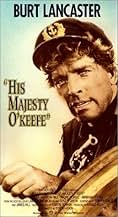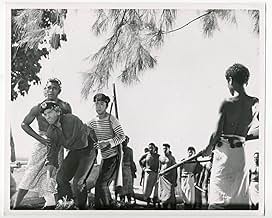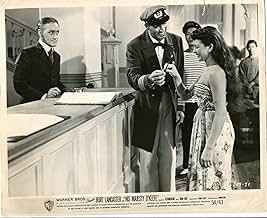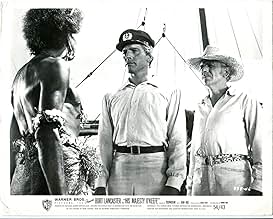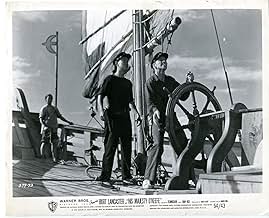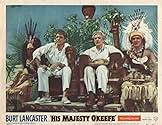VALUTAZIONE IMDb
6,1/10
1524
LA TUA VALUTAZIONE
Aggiungi una trama nella tua linguaA Yankee sea captain has adventures in paradise trying to become an entrepreneur in Micronesia.A Yankee sea captain has adventures in paradise trying to become an entrepreneur in Micronesia.A Yankee sea captain has adventures in paradise trying to become an entrepreneur in Micronesia.
- Regia
- Sceneggiatura
- Star
André Morell
- Alfred Tetins
- (as Andre Morell)
Jimmy Dime
- Sailor at Table in Saloon
- (non citato nei titoli originali)
Sol Gorss
- Tough Sailor in Fight
- (non citato nei titoli originali)
Hugh McLardy
- Hong Kong Tailor
- (non citato nei titoli originali)
Paddy Mulelly
- J.R. Beldon, Bank Manager
- (non citato nei titoli originali)
Recensioni in evidenza
A deeply subversive, yet utterly enjoyable (and kinda true)South Seas movie from the 50's. Burt Lancaster is a typical 19th century trader/pirate whose only ambition is to make money out of the "natives", and fast. He comes to a Pacific Island Utopia where no one has to work... because who needs money?...
Vastly underrrated, this film makes all kinds of points. The Natives (half of whom, admittedly,are white guys in blackface)are dangerous quasi-cannibals. But the white guys (including Burt!)are plain Euro- Trash. The head chief, and Burt's head wife (Joan Rice in a lovely performance - she takes the cliché of the innocent island girl and makes a performance out of it with her eyelashes) are the real heroes.
Did I mention the Chinese dentist who knows more about investments than Burt? Or the German philosophy student who can relate to the natives better than Europeans? Filmed on location in Fiji with a cast that seem to be having the time of their lives, HIS MAJESTY O'KEEFE is a very simple, yet completely fun relic of the non-PC days. (P.S. Check out the other scripts by Borden Chase. Some good ones there...)
Vastly underrrated, this film makes all kinds of points. The Natives (half of whom, admittedly,are white guys in blackface)are dangerous quasi-cannibals. But the white guys (including Burt!)are plain Euro- Trash. The head chief, and Burt's head wife (Joan Rice in a lovely performance - she takes the cliché of the innocent island girl and makes a performance out of it with her eyelashes) are the real heroes.
Did I mention the Chinese dentist who knows more about investments than Burt? Or the German philosophy student who can relate to the natives better than Europeans? Filmed on location in Fiji with a cast that seem to be having the time of their lives, HIS MAJESTY O'KEEFE is a very simple, yet completely fun relic of the non-PC days. (P.S. Check out the other scripts by Borden Chase. Some good ones there...)
Aside from some good old studio stand-bys, like Benson Fong and Philip Ahn (A Korean usually cast as some other Asian), this film has few of the faces that hung around the screens of Hollywood. But, Lancaster teamed up with the lovely Joan Rice from the UK to give us a wonderful tale of adventure in the South Seas. This time, it takes us to the Solomons to the island of Yap, who worship the stone Fey, spirits who reside in stone wheels cut and transported nearly a thousand miles. O'Keefe winds up becoming their king but with profit in mind. He wants to exploit the copra market but the Yap Islanders won't work. So, he hits on the plan to bring their Fey back and this is the beginning. The Solomons were part of the old German trust Islands and there actually was a man named O'Keefe who slipped in by marrying a local girl. But, the Germans, unlike in the movie, eventually kicked him out until they were kicked out after the first world war and then the Island went to the Japanese who were kicked out after the second world war and then...well, you get the idea. I loved this film when I saw it as a kid. No, it's far from perfect but it is a charming story with lots of action and Burt was at his best. But, those beautiful green eyes of Joan Rice were a delight as well. It's too bad we saw so little of her afterwards. Also, there's a lovely song from this film, based in part on Rachmaninov's rhapsody, called Sweet Emerald Isle. Check it out.
This film is not Lancaster's best but is enjoyable if you enjoy watching him in his athletic prime. Beautifully shot, it captures the exciting times of adventure on the high seas and island exploration. The plot is fairly insubstantial and there's nothing new here but at just over 90 minutes, the story never drags. Definitely worth a look if you're a fan of Burt's.
If you like Burt Lancaster, than this film is worth watching. The plot is very silly, and takes place largely in the South Seas. There is the usual large contingent of half-naked South Sea natives interacting with the "white man", although several of the natives with speaking parts are white themselves, as always: Joan Rice and Abraham Sofaer in particular come to mind. And as always, the natives who speak English speak it better than many people I know in real life. Joan Rice, in particular, has a beautiful English accent of dubious ancestry for a native girl (OK, yes, her father was British, but she was brought up in the South Seas and somehow speaks a more polished English than he does).
There are many bad Germans, with very stereotypical movie accents (proto-Nazis?), and one good German, played by Andre Morell, with a less disagreeable accent (although his saying "zee" for "the" gets tiring). His genial friendship with Burt Lancaster is pleasing. Most hilariously, Joan Rice, as Burt Lancaster's eventual wife, looks completely lost most of the time, smiling her way through most scenes, looking like a confused tourist in Paris who doesn't speak the language.
But we started with Burt Lancaster. Burt gets to show off his acrobatic skills in several scenes, swinging on ropes and so forth, although in one shot he is shown only beginning to climb a coconut tree; I would like to have seen him climb to the top. He smiles a lot in this film, and this too is always pleasing.
The plot is too absurd and improbable to describe. Everybody wants the oil of the coconuts, which is very valuable, except the natives themselves. There are too many changes of power on the island, and it is not that interesting to follow. But it is a pleasant enough film, and totally harmless.
There are many bad Germans, with very stereotypical movie accents (proto-Nazis?), and one good German, played by Andre Morell, with a less disagreeable accent (although his saying "zee" for "the" gets tiring). His genial friendship with Burt Lancaster is pleasing. Most hilariously, Joan Rice, as Burt Lancaster's eventual wife, looks completely lost most of the time, smiling her way through most scenes, looking like a confused tourist in Paris who doesn't speak the language.
But we started with Burt Lancaster. Burt gets to show off his acrobatic skills in several scenes, swinging on ropes and so forth, although in one shot he is shown only beginning to climb a coconut tree; I would like to have seen him climb to the top. He smiles a lot in this film, and this too is always pleasing.
The plot is too absurd and improbable to describe. Everybody wants the oil of the coconuts, which is very valuable, except the natives themselves. There are too many changes of power on the island, and it is not that interesting to follow. But it is a pleasant enough film, and totally harmless.
Captain David O'Keefe was a real-life person, a 19th century Irish-born adventurer from Savannah, Georgia, who made his fortune in the copra trade on the South Pacific island of Yap. This film is a fictionalised version of his life-story, and as one might expect takes a few liberties with history. In the film O'Keefe becomes king of Yap and defends his people against the incursions of aggressive German colonisers. In reality, when O'Keefe arrived on the island in 1871 it was a Spanish colony and the newly-united German Empire had no interest in acquiring colonies in the South Pacific or anywhere else. Yap did not become German until 1899, well after the date at which the film is set. This change was possibly made because in 1954, only nine years after the end of the war, American audiences would have been more accustomed to seeing Germans than Spaniards as cinematic villains. The film does, however, provide one "good German" in the shape of O'Keefe's friend Alfred Tetens, another real-life person.
O'Keefe did indeed marry a local girl as shown here, but the film tactfully omits the fact that their marriage was invalid because he already had a wife in Savannah. The Production Code officially forbade the depiction of racially mixed marriages or romances, but by the fifties there seemed to be an unofficial relaxation of this rule in force. Relationships between white men and non-white women could be shown provided (a) the girl was described as being of mixed race and (b) she was played by a white actress. This rule was applied in "Showboat" and "Love is a Many-Splendoured Thing", and is also applied here. O'Keefe's sweetheart Dalabo, supposedly of mixed European and Micronesian descent, is played by the Derbyshire-born Joan Rice. Dalabo has a rival for O'Keefe's affections, but the said rival, being pure- blooded Yapese, has to lose out.
Rice, although undoubtedly decorative to look at, is never really convincing as a native of the South Seas, or for that matter of any part of the world further south than Derbyshire. Burt Lancaster, however, makes an agreeable hero, and receives good support from André Morell as Tetens. Later in his career Lancaster could be a very intense actor, often appearing in dramas with a serious social, political or philosophical purpose, but in his action films of the early fifties his style of acting was generally much more relaxed, and so it is here.
Many film-makers of the early days of the cinema were reluctant to venture too far away from a Hollywood studio, even when their films were ostensibly set in some exotic part of the globe. This attitude still prevailed in some quarters during the fifties; for example "Brigadoon", also made in 1954, had to be shot on MGM's sound stage, against a vast painted backdrop of Scottish-style scenery, because Dore Schary was reluctant to stump up the cost of transporting cast and crew all the way to Scotland, or even to some part of America that looked like Scotland. In other quarters, however, attitudes were changing as the studios began to realise that local colour and authentic scenery could be useful weapons in their battle against the new enemy, television.
"His Majesty O'Keefe" is a case in point, as much of the film was actually shot on location in the South Pacific. This doubtless increased the budget, but I think that the decision was the right one, as the result was a colourful, visually attractive film. Byron Haskin is unlikely to feature very highly on any list of Hollywood's great auteurs, but he was capable of producing some very decent and enjoyable adventure films (his 1953 version of "The War of the Worlds" is probably the best known) and this is another in that category. 7/10
O'Keefe did indeed marry a local girl as shown here, but the film tactfully omits the fact that their marriage was invalid because he already had a wife in Savannah. The Production Code officially forbade the depiction of racially mixed marriages or romances, but by the fifties there seemed to be an unofficial relaxation of this rule in force. Relationships between white men and non-white women could be shown provided (a) the girl was described as being of mixed race and (b) she was played by a white actress. This rule was applied in "Showboat" and "Love is a Many-Splendoured Thing", and is also applied here. O'Keefe's sweetheart Dalabo, supposedly of mixed European and Micronesian descent, is played by the Derbyshire-born Joan Rice. Dalabo has a rival for O'Keefe's affections, but the said rival, being pure- blooded Yapese, has to lose out.
Rice, although undoubtedly decorative to look at, is never really convincing as a native of the South Seas, or for that matter of any part of the world further south than Derbyshire. Burt Lancaster, however, makes an agreeable hero, and receives good support from André Morell as Tetens. Later in his career Lancaster could be a very intense actor, often appearing in dramas with a serious social, political or philosophical purpose, but in his action films of the early fifties his style of acting was generally much more relaxed, and so it is here.
Many film-makers of the early days of the cinema were reluctant to venture too far away from a Hollywood studio, even when their films were ostensibly set in some exotic part of the globe. This attitude still prevailed in some quarters during the fifties; for example "Brigadoon", also made in 1954, had to be shot on MGM's sound stage, against a vast painted backdrop of Scottish-style scenery, because Dore Schary was reluctant to stump up the cost of transporting cast and crew all the way to Scotland, or even to some part of America that looked like Scotland. In other quarters, however, attitudes were changing as the studios began to realise that local colour and authentic scenery could be useful weapons in their battle against the new enemy, television.
"His Majesty O'Keefe" is a case in point, as much of the film was actually shot on location in the South Pacific. This doubtless increased the budget, but I think that the decision was the right one, as the result was a colourful, visually attractive film. Byron Haskin is unlikely to feature very highly on any list of Hollywood's great auteurs, but he was capable of producing some very decent and enjoyable adventure films (his 1953 version of "The War of the Worlds" is probably the best known) and this is another in that category. 7/10
Lo sapevi?
- QuizAlthough heavily Hollywoodized, the film is based on real individuals and events. There is a boutique hotel in Yap named after him (O'Keefe's), and the style of construction reflects the architecture of O'Keefe's time.
- BlooperO'Keefe returns to Hong Kong and stock footage is shown of people walking down a street. However, the movie is set in the 1870s and the footage is of 1950s Hong Kong. Giveaways include signs such as "No Motors".
- Citazioni
Capt. David O'Keefe: Goodbye, Fatumak. Thank you for everything. Goodbye!
Fatumak, Medicine Man: There are no goodbyes between friends.
[handing him a necklace]
Fatumak, Medicine Man: This is the whale's tooth of remembrance until we meet again.
- ConnessioniFeatured in A Fellow Journeyman: Byron Haskin at Paramount (2022)
I più visti
Accedi per valutare e creare un elenco di titoli salvati per ottenere consigli personalizzati
- How long is His Majesty O'Keefe?Powered by Alexa
Dettagli
- Data di uscita
- Paese di origine
- Lingua
- Celebre anche come
- His Majesty O'Keefe
- Luoghi delle riprese
- Viti Levu, Fiji(village of Goloa)
- Azienda produttrice
- Vedi altri crediti dell’azienda su IMDbPro
Botteghino
- Budget
- 1.550.000 USD (previsto)
- Tempo di esecuzione
- 1h 31min(91 min)
Contribuisci a questa pagina
Suggerisci una modifica o aggiungi i contenuti mancanti



